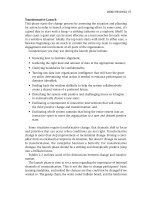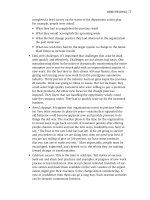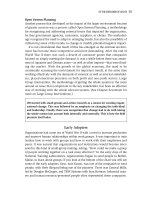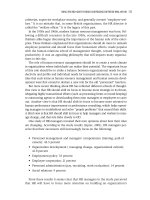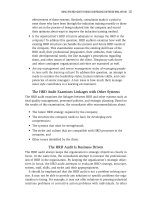Practicing Organization Development (A guide for Consultants) - Part 61 potx
Bạn đang xem bản rút gọn của tài liệu. Xem và tải ngay bản đầy đủ của tài liệu tại đây (192.85 KB, 10 trang )
Technical Architecture
OD practitioners who recognize the enormous impact that collaborative tech-
nologies can offer to their work with clients are faced with two opportunities:
the first is to move existing processes online by utilizing combinations of these
new communication and collaboration tools; the second is to define entirely new
interventions and approaches based on the creative possibilities that these tools
present. Yet sorting through the growing body of available technology tools can
be a daunting task, especially because many of these tools were not designed to
facilitate specific group processes per se, but rather serve as platforms for gen-
eral communication, collaboration, learning, and knowledge management.
Table 24.2 lists a number of websites where additional resources and infor-
mation about collaborative tools and technologies can be found. To simplify the
discussion of potentially useful technology and provide an orientation to these
tools as they might serve the needs of OD practitioners, we have divided
these tools into two categories: synchronous and asynchronous.
TECHNOLOGY AND ORGANIZATION DEVELOPMENT 571
Table 24.2. Online Resources*
Website Description URL
BRINT Business technology portal www.brint.com
Center for Directory of websites www.workteams.unt.edu/links.htm
Collaborative focused on virtual teams,
Organizations online facilitation, and OD
CIO Magazine Business technology www.cio.com
magazine
Gilgordon.com Directory of collaboration www.gilgordon.com/resources/
software and tool providers products1.htm
HR-Software.net HR software directory www.hr-software.net
KM.Gov Knowledge management
resources including www.km.gov
information on
communities of practice
Kolabora Collaboration www.kolabora.com
technology portal
Learning Circuits e-Zine focused on www.learningcircuits.org
online learning
Survey Monkey Directory of online www.surveymonkey.com/Pricing.asp
survey tools
*To obtain access to an online demonstration site that provides examples of tools for team decision sup-
port and other group processes, contact the author at
32_962384 ch24.qxd 2/3/05 12:23 AM Page 571
Synchronous Tools
Synchronous tools enable real-time communication and collaboration at the
same point in time. The major benefit of synchronous tools is that they are
“high touch”—they provide the highest degree of interaction outside of face-to-
face meetings. The primary drawback of synchronous tools is that, by defini-
tion, they require same-time participation—different time zones and conflicting
schedules can create communication challenges. Table 24.3 outlines the most
common synchronous tools and technologies.
Asynchronous Tools
Table 24.4 outlines some of the asynchronous tools that are available and that
enable communication and collaboration over an extended period of time. These
tools allow people to connect together at each person’s own convenience and
schedule. Asynchronous tools are useful for sustaining dialogue and collabora-
tion over a period of time and providing people with resources and information
572 PRACTICING ORGANIZATION DEVELOPMENT, 2ND EDITION
Table 24.3. Synchronous Tools
Tool Useful for Drawbacks
Audio Conferencing Discussions and dialogue Time zones, especially when
international participation is
involved; inability to read body
language
Web Conferencing Sharing presentations and Bandwidth; may also require
information audio conferencing to be useful
Video Conferencing In-depth discussions with Cost; current limited availability
higher-touch interactions of video conferencing systems
Chat Information sharing of Usually requires typing; can feel
low-complexity issues “slow” to participants
Instant Messaging Ad hoc quick All users must use compatible
communications system; can feel intrusive
White Boarding Co-development of ideas Bandwidth; may also require
audio conferencing to be useful
Application Sharing Co-development of Bandwidth; may also require
documents audio conferencing to be useful
32_962384 ch24.qxd 2/3/05 12:23 AM Page 572
TECHNOLOGY AND ORGANIZATION DEVELOPMENT 573
Table 24.4. Asynchronous Tools
Tool Useful for Limitations
Discussion Boards Dialogue that takes place May take longer to arrive at
over a period of time decisions or conclusions
Web Logs (Blogs) Sharing ideas and May take longer to arrive at
comments decisions or conclusions
Messaging (email) One-to-one or one-to-many May be misused as a
communications “collaboration tool” and
become overwhelming
Streaming Audio Communicating or Static and typically does not
teaching provide the option to answer
questions or expand on ideas
Streaming Video Communicating or Static and typically does not
teaching provide the option to answer
questions or expand on ideas
Narrated Slide Shows Communicating or Static and typically do not
teaching provide the option to answer
questions or expand on ideas
“Learning Objects” Teaching and training Typically does not provide the
(web-based training) option to answer questions
or expand on ideas in
detail
Document Libraries Managing resources Version control can be an
issue unless check-in/
check-out functionality is
enabled
Databases Managing information Requires clear definition and
and knowledge skillful administration
Web Books Teaching and training Not dynamic and may lose
interest of readers
Surveys and Polls Capturing data and Requires clear definition and
information ongoing coordination
Shared Calendars Coordinating activities System compatibility
Website Links Providing resources May become outdated
and references and “broken”
32_962384 ch24.qxd 2/3/05 12:23 AM Page 573
that are instantly accessible, day or night. Asynchronous tools possess the advan-
tage of being able to involve people from multiple time zones. In addition, asyn-
chronous tools are helpful in capturing the history of the interactions of a group,
allowing for collective knowledge to be more easily shared and distributed. The
primary drawback of asynchronous technologies is that they require some dis-
cipline to use for ongoing communities of practice (for example, people typically
must take the initiative to “log in” to participate) and they may feel “impersonal”
to those who prefer higher-touch synchronous technologies.
While real-time communication can help foster bursts of intense participa-
tion, asynchronous technologies provide the best medium for sustaining col-
laboration over time (Figallo, 1998). Members can engage with others at the
time and place most convenient for them. New members can join the group and
quickly understand the context of where the group has been and where it is
going. Knowledge is naturally captured and can be shared with others.
There are benefits to, and challenges with, both synchronous and asynchro-
nous tools. The most comprehensive approaches blend tools to create a seam-
less flow among in-person, synchronous, and asynchronous online processes
(for example, periodic face-to-face gatherings followed by regular virtual
meetings supported with real-time conferencing tools and an always-accessible
collaborative workspace).
A significant step beyond this smorgasbord of individual tools are web-based
platforms that aim to provide some or most of the functionality of these stand-
alone tools, but do so within a single integrated collaborative environment. The
integration and synthesis of these tools creates a container that turns out to be
far greater than the sum of its parts and can become the single portal for all
activities of a group or change process. Going beyond the hodgepodge of
individual tools can elevate the value of technology by encouraging ongoing
collaborative learning and knowledge sharing.
The following features and capabilities tend to be shared among integrated,
collaborative platforms and distinguish them from mere collections of side-by-
side communication and collaboration tools:
Integrated Collaborative Environments
• Integrated Functionality. Whereas a wide variety of tools exist and may
be used independently, online collaborative environments that integrate
functionality serve to streamline communication and collaboration. For
example, when creating a shared calendar listing for an upcoming event,
one might at the same time also send an announcement to those who
are invited to attend, provide a clickable button to RSVP, and attach a
map and agenda for the event.
• Consistency in the User Interface (UI). Rather than presenting people with
a potpourri of tools and user interfaces, integrated online environments
574 PRACTICING ORGANIZATION DEVELOPMENT, 2ND EDITION
32_962384 ch24.qxd 2/3/05 12:23 AM Page 574
offer rich functionality and a consistent “user experience.” This consis-
tency reduces the learning curve and allows people to communicate
quickly and seamlessly using the modes that are appropriate to the issue
or task at hand. This is especially important for those individuals less
comfortable with using computers and related collaboration tools since
one isolated, frustrating experience can lead to a general dismissal of the
utility of technology itself.
• Scalability and Configurability. Being able to enable or disable features
at any time provides the ability to roll out new capabilities as a group’s
needs change. By providing a scaled rollout of functionality, people can
be led through a process that allows them to learn about new features
over time and subsequently receive the necessary training to use them
in ways that support the activities of the community.
• Customization. Allowing for a high degree of customization, not just in
design but also in the terminology used to describe the various adminis-
trative and leadership roles, including specific activities and processes,
reinforces a distinct sense of identity and purpose.
• Roles and Identity. Providing a structure that defines roles and gives a
distinct identity to individuals, groups, group leaders, administrators,
and so on, allows people to understand how the community will be
developed and managed and what their role is in driving success. This
includes customizable personal profiles that incorporate photographs,
website links, etc.
• Self-Organization. Determining and finding a balance between “facilitat-
ing” or “managing” the community versus establishing a context in which
the community itself takes responsibility for its ongoing organization is
one of the more challenging tasks facing the social architect of a commu-
nity. Since online communities exist to serve their members and will only
survive to the extent that the membership finds itself engaged in ways
that have obvious value, creating mechanisms for self-organization where
appropriate is essential for long-term success. Collaborative platforms typ-
ically can be configured to provide designated spaces for self-registration
into special-interest groups and topic areas.
• Activity Tracking. By providing administrators or other community
facilitators with information about who is participating in what ways, it
becomes possible to encourage certain people to become more involved,
just as in a face-to-face meeting in which a facilitator “draws out” those
who may be reserved or “holding back.”
• Persistence. Because communications, documents, and the overall expe-
rience and knowledge of the group are archived and persist over time,
TECHNOLOGY AND ORGANIZATION DEVELOPMENT 575
32_962384 ch24.qxd 2/3/05 12:23 AM Page 575
the group maintains a sense of shared history. Persistence allows people
to obtain context for current decisions, helps newcomers assimilate
rapidly, and essentially serves as the memory of the community.
• Training and Support. Depending on the needs of the community, there
is typically a range of training and support options available. Self-service
training and support includes streaming media tutorials and online help.
Higher-touch training and support is available from certain providers
who understand their role not simply to be software vendors, but to
serve as consultants to organizations on how technology can be used
and how the technical architecture can change to reflect the growth and
evolution of the “social architecture” over time.
Integrated collaborative environments are essential for providing that “sense
of place” that provides people with a feeling of belonging to a “home base”
online. But while connecting within an integrated collaborative environment
provides a strong foundation for engaging with others online, facilitating pro-
ductive online interactions takes a lot more than simply turning on software. It
requires a deep understanding of the needs and motivations of members, sen-
sitivity to the appropriate social architecture that will drive participation, and
awareness of the connection of measurable results to a group’s goals.
Social Architecture
As previously noted, social architecture includes the norms, roles, values, and
group processes that support the use of and interaction with a given technol-
ogy. Just as any good consultant will facilitate introductions, set expectations,
and ensure equal participation, these same approaches can and should be
applied in the online world. While differences between online and in-person
facilitation definitely exist, many practitioners unnecessarily discount their skills
when it comes to facilitating online meetings and building web-based commu-
nities for project collaboration, learning, or knowledge sharing. In describing
approaches for defining and managing social architecture, we make the dis-
tinction between design principles and facilitation strategies. For example:
Design Principles
• Clearly define roles—Describe the relationship between the different
roles in the community (including the sponsor, facilitator, subgroups,
group leaders/facilitators, and individual participants) and outline their
responsibilities and interdependencies.
• Create subgroups—Create subgroupings of participants who have
their own online space for small group learning activities and project
collaboration.
576 PRACTICING ORGANIZATION DEVELOPMENT, 2ND EDITION
32_962384 ch24.qxd 2/3/05 12:23 AM Page 576
• Support individuality—Provide a way for participants to create personal
profiles that contain their photos and salient information about their
backgrounds.
• Identify technical constraints and enablers—Every community possesses
unique attributes and aspirations. For some, using technology comes
second nature, while for others, connecting online may be a significant
challenge. Understanding the technical abilities, including available
computing resources, bandwidth, and related knowledge is essential to
creating a community-building approach that optimizes technology
without overextending its utility.
• Create a technology roadmap that links short-term objectives to long-term
goals—Rather than wait until the “perfect” technical solution is avail-
able, practitioners who understand the core technical features necessary
for short-term success can start small and move gradually or quickly as
the results invite. As time passes, new tools and capabilities may be
introduced that further elevate the cooperative potential of the group.
• Define a roll-out strategy that starts with the core and expands outward—
While a compelling purpose may inspire the desire to “start big,” start-
ing with the “core” and involving selected insiders and key stakeholders
may mean the difference between slow versus rapid adoption of the
technology. By engaging the opinion leaders, key stakeholders, and
sponsors before the rest of the community, it is possible to create
“seeds” within a collaborative online environment (for example, infor-
mation, communications, and other content) that create excitement and
immediate interest when introduced to the larger group.
• Establish roles and processes that support both structured and organic
collaboration—Establishing specific roles to facilitate and promote both
formal and informal collaboration creates focused momentum for an
online community. However, the trick lies in assessing participants’
motivations and needs to find the right balance between managing and
facilitating collaborative processes versus simply creating a context for
collaboration to emerge organically.
• Link participation to measures and rewards—Establishing measures of
success and reward systems tied to reaching goals that must be achieved
by using technology can motivate people to try, and then continue to
work with various tools.
• Build feedback loops for continuous learning and adaptation—Building
in communication mechanisms with sponsors, group leaders, and the
users of a technology is essential for ongoing success. Feedback loops
allow facilitators to do more of what works and less of what does not.
TECHNOLOGY AND ORGANIZATION DEVELOPMENT 577
32_962384 ch24.qxd 2/3/05 12:23 AM Page 577
Facilitation Strategies
• Articulate a cohesive purpose—A purpose that aspires to transformative
results will inspire people to collaborate in ways consistent with the
expressed intent and objectives of the community. Enlist the sponsor to
clearly articulate the purpose of the community or initiative and how
technology supports this purpose.
• Define compelling benefits at the individual, organizational, and global
levels—Grounding the technology’s purpose in practical reality is essen-
tial for ensuring that all members’ needs are met, short- and long-term.
Being conscious to deliver specific benefits to the key stakeholders of
the community over time ensures that the group stays true to purpose
and focused on tangible results for all.
• Directly involve formal and informal leaders—Engaging sponsors, team
leaders, and other influencers early in the process demonstrates support
for and the value of the technology. When formal and informal leaders
directly experience the benefits of the technology, and are then coached
to communicate these benefits to others, participation becomes infec-
tious and resistance is replaced by adoption.
• Establish common values—Establishing and aligning expectations to
shared objectives, including how individuals’ online contributions con-
tribute to the greater purpose of the group, helps create an environment
characterized by sharing and openness. Collaboratively defining the
common values and behavior that will contribute to the overall success
of the group also supports operating norms.
• Establish operating norms—Provide guidelines for online (and offline)
etiquette and obtain agreement on the behavior that will lead to suc-
cessful group and individual results (for example, everyone logs in
three times a week, everyone posts one question and one response on
the discussion board).
• Define standards of conduct to create trust—While common values will
often, themselves, guide collaboration, the sponsor may establish formal
boundaries for desired behavior. Espousing copyright adherence for doc-
uments, confidentiality of discussions, and other standards of conduct
will help set a formal context for trust.
• Ensure privacy—People should be ensured that their communications
and contributions will be used in the service of the larger group—not
provided to or viewed by others for reasons outside the common pur-
pose that bonds the group together.
• Use events to drive participation—Providing people with a reason to come
together, especially in the beginning, can be critical to the development of
578 PRACTICING ORGANIZATION DEVELOPMENT, 2ND EDITION
32_962384 ch24.qxd 2/3/05 12:23 AM Page 578
the online community. Online events, either synchronous or asynchro-
nous, give people the impetus to connect together and experience the pos-
sibilities of communicating and collaborating through technology. If the
experience engages them, they will come back for more.
• Keep content fresh—Content, including articles, presentations, white
papers, online learning tools, audio, and video clips, can be used as the
impetus for greater collaboration. Providing and announcing new infor-
mation and resources at regular intervals contributes to the overall value
of participation.
• Recognize exemplary members and encourage those who are less active—
Like any reward system, recognition of exemplary behavior sets the
standard for the rest of the community. Highlight examples of exemplary
collaboration. Summarize the dialogue of the more active participants.
And for those less-active members, provide them with a personal mes-
sage and offer them special support.
THE FUTURE OF TECHNOLOGY AND OD
The future of technology and OD is a bright one. Never before have we had so
many options for expanding the impact of our work and enabling the quality of
connections that can lead to true learning organizations. And emerging
technologies will continue to provide new ways for individuals, groups, and
organizations, unconstrained by time zones or geographical dispersion, to com-
municate, collaborate, learn together, and build new knowledge.
As the Internet, web-based communication and collaboration tools, online
learning, and collaborative knowledge-sharing take hold within organizations
of all types and sizes, practitioners will face new opportunities and challenges.
Church, Gilbert, Oliver, Paquet, and Surface (2002) suggest:
“It is critical that OD professionals are given the appropriate training in IT and
technology-related areas to be able to fully understand the implications involved
in their implementation and to help apply and communicate to others the
importance of this direction for the future of the field (Church, Waclawski, &
Berr, 2002; McDonah & Coghlan, 1999). This is one of the many reasons why
various practitioners over the past few years have called for change in the very
fundamentals of how they train, legitimatize, and professionalize OD practition-
ers as certified for practice. Although the contribution of technology to OD
efforts is clearly evident, the opportunities to ensure that these new methodolo-
gies and applications are applied in an appropriate and professional manner
may well be the next major hurdle for the field.” (p. 507)
TECHNOLOGY AND ORGANIZATION DEVELOPMENT 579
32_962384 ch24.qxd 2/3/05 12:23 AM Page 579
Beyond learning to use technology and apply such tools in a professional
way, practitioners have the opportunity to establish new approaches at the inter-
section of technology and process. Increasingly, practitioners will be presented
with opportunities to evaluate the utility of technology for supporting existing
practices, replacing these practices with more effective models that incorporate
technology, or creating entirely new approaches that expand stakeholder
involvement and elevate the impact of the intervention through unique combi-
nations of tools. At the center of any of these approaches remains the need to
consider how the values of OD can stay a constant in our work.
If ever we as practitioners have needed to transfer our skills and capabilities
to our client systems, it is now. Communication tools and technologies are used
every day by virtually every function of every organization. As organizations
adopt new technologies, many do not consider the social architecture that must
be designed into these tools to support effective group processes and organiza-
tional learning. As practitioners become more versed in using technology, and
as they introduce new tools into their client organizations, there will be a press-
ing need to transfer new capabilities—to give our clients the experiences,
insights, and skills for using technology in ways that honor the importance of
and the role of the social systems and processes that ultimately make technology
work in the first place.
More and more technologies are designed and supported by people who
understand behavioral science and the approaches that support healthy, pur-
poseful group and organizational transformation. Web-based tools for conduct-
ing surveys, 360-degree feedback, mind mapping, and brainstorming are already
available today. New technologies will emerge in the future that take today’s
technology-enabled interventions to the next level. Integrated collaborative
environments will support a wider range of group processes, data gathering,
mentoring, collaboration, and knowledge-sharing activities. These technologies
will seamlessly integrate with the individual tools of today while offering
broader communications and collaboration capabilities. Practitioners will have
the opportunity to customize and morph these tools and their interventions to
fit the unique lifecycles of the groups and organizations that they serve.
References
Allee, V. (2002). The future of knowledge: Increasing prosperity through value networks.
Burlington, MA: Butterworth-Heinemann.
American Productivity & Quality Center. (2001). Building and sustaining communities
of practice: Continuing success in knowledge management. Houston, TX: American
Productivity & Quality Center.
Ashkenas, R., Ulrich, D., Jick, T., & Kerr, S. (1995). The boundaryless organization:
Breaking the chains of organizational structure. San Francisco: Jossey-Bass.
580 PRACTICING ORGANIZATION DEVELOPMENT, 2ND EDITION
32_962384 ch24.qxd 2/3/05 12:23 AM Page 580





